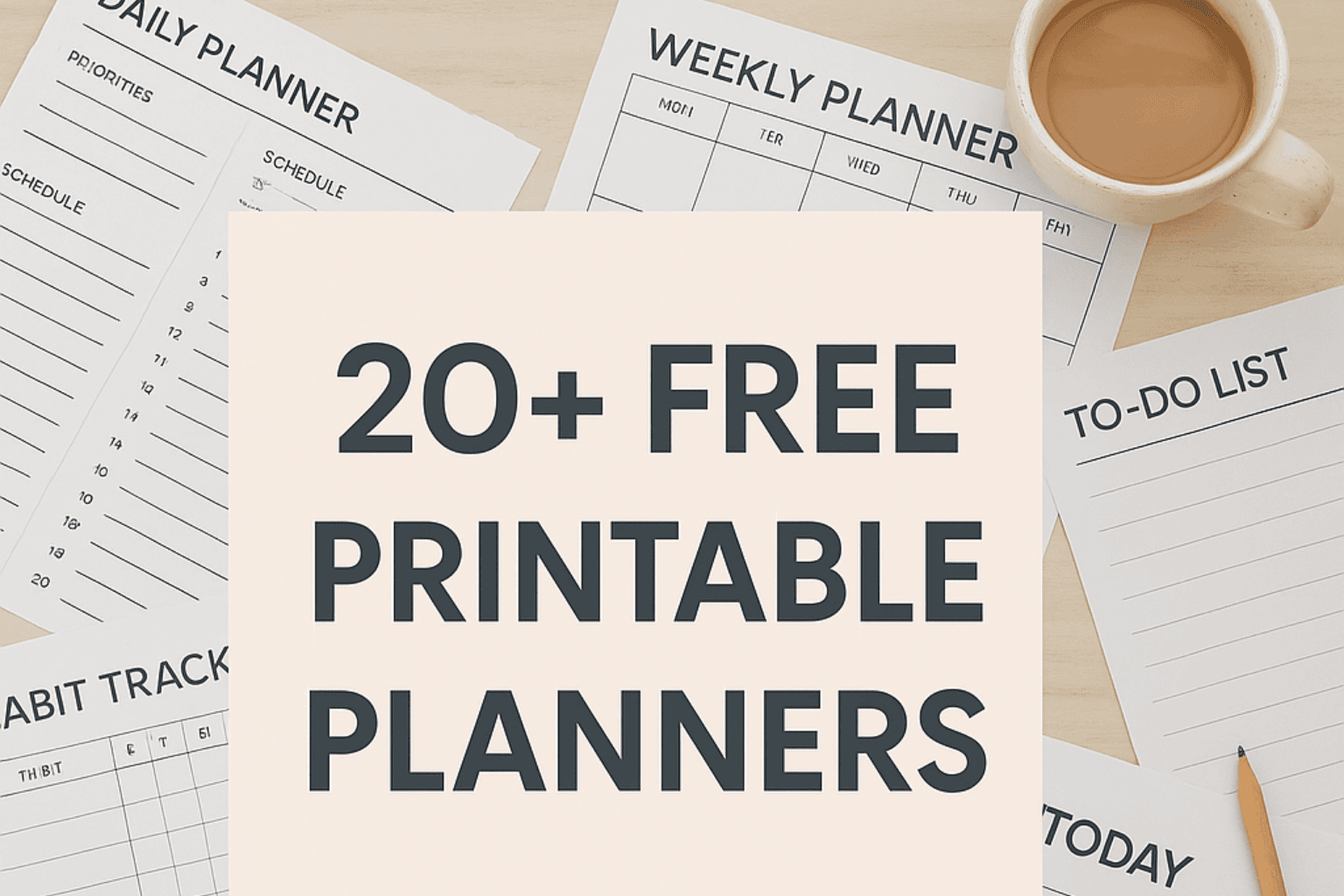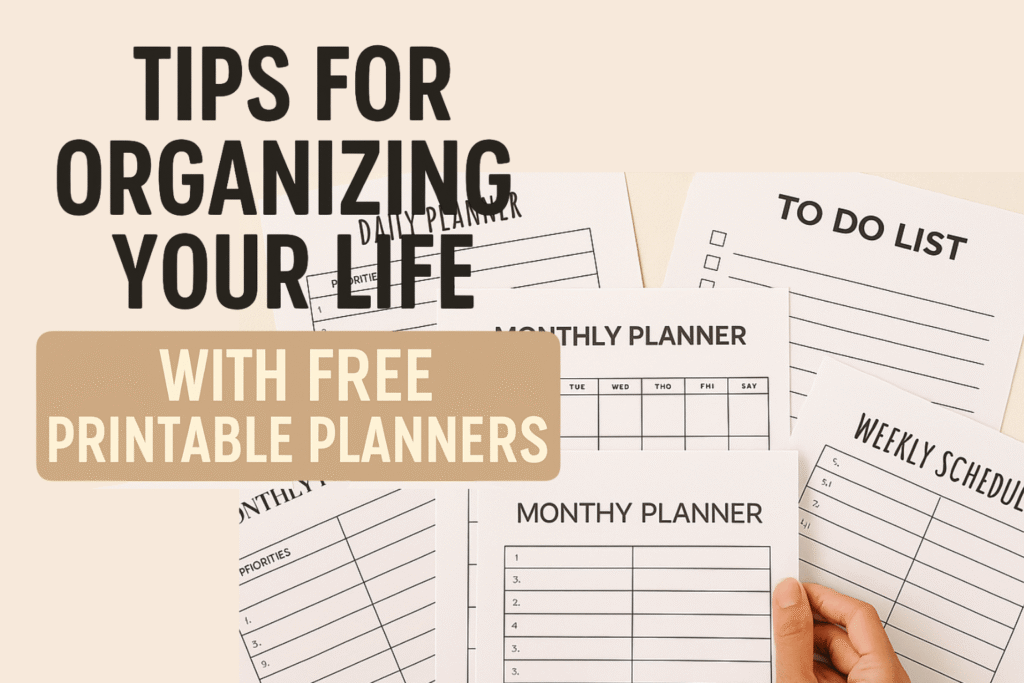If you like planning on paper, this is for you. We’ve rounded up Free Printable Planners you can download and use right away—no signup, no hoops. Print a few pages, slip them into a binder, and you’ve got a simple planning system you can actually stick with. These planners cover the basics (daily, weekly, monthly), plus helpful extras like meal planning, budgeting, content calendars, study pages, and more.
In this guide, you’ll find tips for choosing the right layouts, quick print settings that make everything look clean, and a big list of ready-to-use planner pages you can start with today. We’ll also point you to a few related resources—like how to organize your life with printables, or how to build a simple landing page if you want to share your own planner set with others.
Why printable planners still work
Digital tools are great, but paper has some quiet advantages:
- No app switching or notifications
- Easy to see your week at a glance
- Writing helps you remember and commit
- Cheap, flexible, and easy to customize
If you’re trying to start fresh or rebuild a routine, Free Printable Planners are a low-friction way to get going without buying an expensive system.
More read: Tips for Organizing Your Life with Free Printable Planners — practical ways to set up a lightweight planning routine.
Download & print basics (so pages look crisp)
A few quick notes before you hit print:
- File type: Most planners are PDF. Open in your browser or a PDF viewer.
- Paper size: Many sets include US Letter (8.5×11) and A4. Pick the one that matches your paper.
- Print scale: Set to 100% or “Actual size.” Turn off “Fit to page” unless the file instructs otherwise.
- Margins: If your printer can’t do borderless, a small white border is normal.
- Color vs. black & white: Many pages print nicely in grayscale to save ink.
- Hole punch: Plan ahead for left or top margins if you’re using a binder.
- Reuse: Laminate a few high-use pages (like meal plans) and write with a dry-erase marker.
Prefer tablets? You can still use these PDFs in a notes app and write with a stylus. If you lean fully digital, you may like a dashboard approach—see Top Tips for Using Notion Templates for Daily Productivity.
How to choose the right layout
Pick one primary layout for structure (daily or weekly), then add 2–3 support pages that match your goals:
- Daily + Habit + To‑Do if you want a tight routine
- Weekly + Meal + Cleaning for home rhythm
- Monthly + Budget + Bill Tracker for finances
- Content + Social Calendar + Project if you create online
Start small. Print 5–10 pages, try them for a week, and adjust.
20+ Free Printable Planners (instant download)
Below are practical, mix‑and‑match pages. Print what you need; ignore the rest. All designed to be clean, straightforward, and easy to read.
1) Daily Planner (timed & untimed)
A single page for today’s plan—top priorities, time blocks, notes, and a small habit box.
Best for: Busy weekdays when you want a plan you can see at a glance.
Tip: If your schedule shifts, choose the untimed version and write time blocks as needed.
2) Weekly Planner (horizontal & vertical)
See your whole week on two pages or one. Horizontal gives you daily boxes; vertical suits time blocking.
Best for: Balancing appointments and tasks across work, home, and personal goals.
Pair with: A habit tracker to build consistency.
3) Monthly Calendar (undated)
Clean grid with room for key dates and deadlines. Undated means you can print once and reuse.
Best for: Big-picture planning and monthly themes.
Tip: Use small sticky notes for events that might move.
4) Year at a Glance
All months on two pages. Track milestones, trips, launches, and school breaks.
Best for: Planning seasons and long-term goals at a glance.
Tip: Color-code categories (work, family, personal).
5) To‑Do List (simple & categorized)
Minimal checklists—plain or grouped by context (home, work, errands).
Best for: Brain dumps and quick wins.
Tip: Mark 1–3 high-impact tasks and give them a star.
6) Habit Tracker (monthly grid)
A grid with days across the top and habits down the side.
Best for: Building a routine (water, steps, reading, bedtime).
Tip: Don’t track everything—pick 3–5 habits that truly matter.
7) Goal Planner & Monthly Review
One page to set a clear goal and steps, another to review what worked.
Best for: Staying focused instead of juggling too many goals.
Tip: Tie goals to specific weeks in your monthly calendar.
8) Time‑Blocking Schedule
Columns by hour (or half hour) for deep work and breaks.
Best for: Freelancers, students, and anyone with variable days.
Tip: Block meetings last; protect your core work first.
9) Meal Planner + Grocery List
Weekly menu on one side, categorized shopping list on the other.
Best for: Saving time and reducing cost at the store.
Tip: Keep a rotating list of easy dinners to fill gaps.
10) Budget Planner (monthly)
Income, fixed bills, variable spend, and savings on one clean page.
Best for: Quick financial check-ins that actually happen.
Tip: Pair with an expense log for the first two months, then simplify.
11) Bill Tracker
A simple table to mark due dates and payment status.
Best for: Preventing late fees and keeping mental space clear.
Tip: Add autopay notes so you know what’s hands‑off.
12) Expense Tracker
Columns for date, category, amount, and notes.
Best for: Building awareness so you can set a realistic budget.
Tip: Log expenses every two days so it doesn’t pile up.
13) Fitness Planner & Workout Log
Plan workouts for the week; track sets, reps, or minutes.
Best for: Staying consistent without fancy apps.
Tip: Print two per week—one for plan, one for results.
14) Wellness & Self‑Care Planner
Simple prompts: sleep, water, movement, mood, one small treat.
Best for: Steadier energy and stress management.
Tip: Keep this near your daily or weekly page to stay mindful.
15) Study Planner & Assignment Tracker
Study blocks, course list, deadlines, and a grade tracker.
Best for: Students, course takers, or certification prep.
Tip: Add a “review session” box two days after each study block.
16) Content Planner (creators)
Editorial calendar with idea bank, status tags, and publish dates.
Best for: Bloggers, YouTubers, and newsletter writers.
Tip: Keep ideas and outlines on the same page.
Read: Lead Magnet Ideas You Can Build in Canva (With Free Templates)
17) Social Media Calendar
A weekly grid with platform icons, post ideas, and CTA notes.
Best for: Planning batches of posts in one sitting.
Tip: Add a small tracker for “drafted, scheduled, posted.”
Read: Top Free Canva Templates for Social Media & Branding
18) Project Planner
Scope, milestones, resources, and a simple timeline.
Best for: Work projects, home improvements, or launches.
Tip: Break milestones into two-week chunks for momentum.
19) Cleaning Schedule (weekly & monthly)
Weekly checklist plus a rotating monthly deep‑clean list.
Best for: Keeping clutter at bay without huge cleaning days.
Tip: Assign tasks to rooms, not people; assign people to rooms.
20) Travel Planner & Itinerary
Packing list, dates, bookings, and daily plans.
Best for: Stress‑free travel without searching email threads.
Tip: Print an extra for return travel day.
21) Event or Party Planner
Budget, guest list, menu, activities, and timeline.
Best for: Birthdays, showers, or community events.
Tip: Add a “borrowed items” line so you remember to return things.
22) Wedding Planner (starter)
Budget overview, vendor list, checklist by month.
Best for: A calm starting point before details multiply.
Tip: Keep a master contact sheet and venue rules page in front.
23) Reading Log & Book Tracker
Books to read, in progress, finished, with short notes.
Best for: Personal reading projects or class lists.
Tip: Add “why this book” so your picks have purpose.
24) Recipe Cards & Binder Pages
Minimal recipe cards and a divider page for categories.
Best for: Building a family cookbook or meal rotation.
Tip: Print on heavier paper so cards hold up.
25) Gratitude & Reflection Journal (one‑page)
Three lines a day for gratitude and one small win.
Best for: Ending the day on a calmer note.
Tip: Keep it paired with your daily planner for an easy habit.
Simple binder setup (takes 10 minutes)
- Pick a binder: 1–1.5 inch is enough for most people.
- Print a starter pack: Daily/weekly, habit, meal, budget, and one “notes” page.
- Create sections: Time, Home, Money, Projects, Notes. Use sticky tabs.
- Reprint as needed: Keep 10–15 copies of your most-used pages in the back.
Tips to stick with planning (without turning it into a chore)
- Plan at the same time every day. Morning coffee or evening wind‑down both work well.
- Limit your task list. Pick three must‑do items; everything else is a bonus.
- Batch chores and errands. Group tasks by location or tool.
- Make it visible. Keep your binder open on your desk or kitchen counter.
- Review weekly. Sunday evening or Monday morning—your choice.
- Be flexible. If a page doesn’t fit, print a different one next week.
Share your own printables (if you create them)
If you want to publish your own planner set, a small “free starter” pack is a great way to start. You can offer it as a direct download and later add a paid upgrade (dated versions, extra styles, or a full home binder).
- Design in Canva: Start with minimal layouts and add your brand touch.
- Package cleanly: PDFs in A4 + Letter, a one‑page “How to use,” and a print settings note.
- Display with mockups: A few simple lifestyle scenes help people picture the pages in use.
- Offer a Pro version: Extra pages, dated calendars, and matching stickers or icons.
FAQs
Do these planners work in grayscale?
Yes. Most are designed with light lines and simple text so they print cleanly in black and white.
What paper weight should I use?
Standard copy paper (20 lb) is fine. If you write with markers or highlighters, try 24–28 lb.
Can I punch these for a disc‑bound system?
Yes. Leave a little extra left margin when you print or scale to 95% if needed.
How do I keep from printing too much?
Start with a 7‑ to 10‑day stack. Reprint only the pages you actually used.
Are there digital versions?
Most PDFs can be imported into a notes app for tablet writing. If you prefer all‑digital, try a Notion dashboard—Top Tips for Using Notion Templates for Daily Productivity has ideas.
A quick starter stack you can print now
If you want something simple that works this week, try this 10‑page set:
- 3 × Daily Planner
- 1 × Weekly Planner
- 1 × Habit Tracker
- 1 × Meal Planner + Grocery List
- 1 × Budget Planner
- 1 × Bill Tracker
- 1 × To‑Do List
- 1 × Notes / Brain Dump
Put these in a thin binder with two sticky tabs: Plan and Home. Review every evening or morning and adjust as needed.
Final thoughts
Paper planning doesn’t have to be complicated. With Free Printable Planners, you can build a calm, flexible system that fits your life—no login, no learning curve. Start with one primary layout (daily or weekly), add two or three support pages that match your goals, and give it a week. If something feels clunky, swap it. The best planner is the one you actually use.


